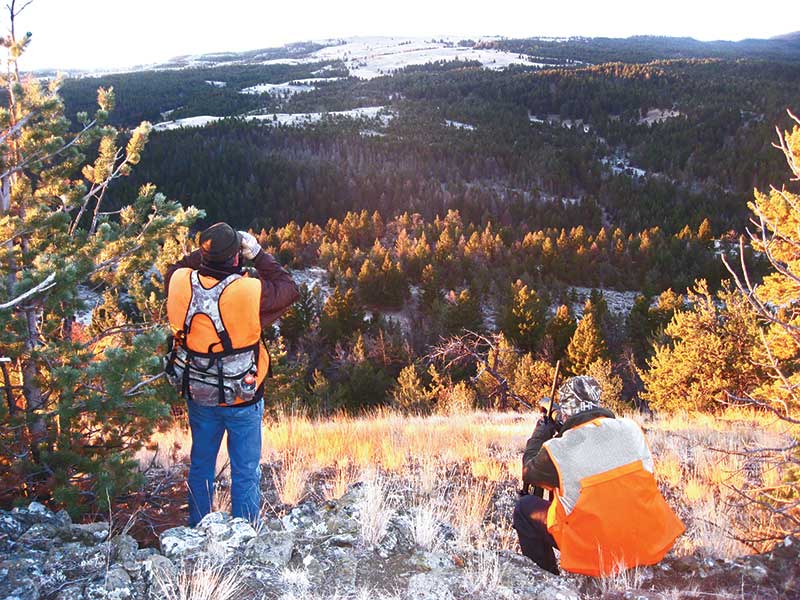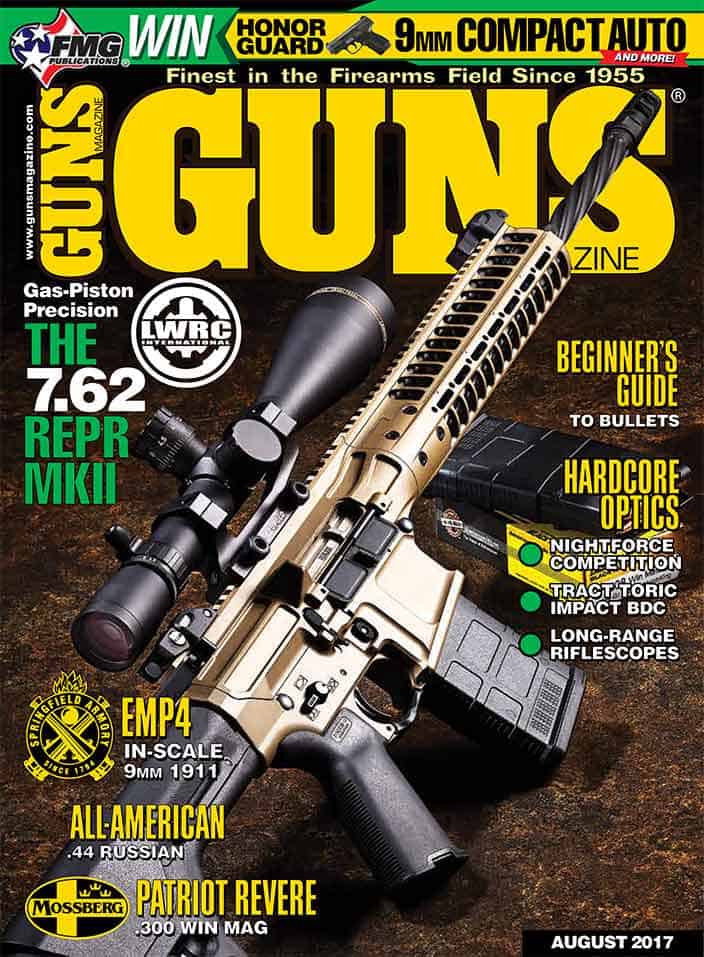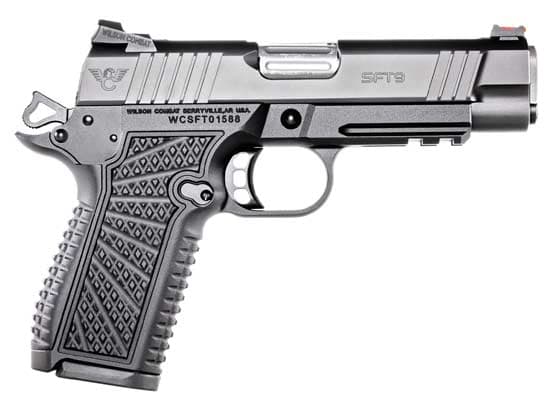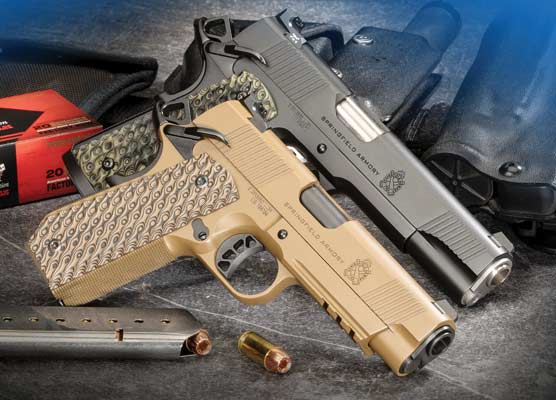Moving The Goal Posts
The Definition Of “Long Range” Is Growing Ever Outward,
But Today The Rifles And Optics Are More Capable Than Ever.
The earliest scopes were simple, fixed-power telescopes with the addition of a reticle for aiming, sighted-in by moving, bending or shimming the mounts, but soon precisely adjustable windage and elevation adjustments were included in the rear mount. These were more reliable than the internal adjustments of later scopes, since they didn’t need to be miniaturized to fit inside a small tube. The elevation adjustment was often as sure as a good receiver sight’s.
However, external adjustments were open to dirt, water and bumps, and eventually many hunters preferred internal adjustments, especially after smokeless powder greatly increased muzzle velocities. The flatter trajectory allowed sighting-in for the longest possible “point-blank” distance, then leaving the adjustments alone. But some varmint and target shooters preferred externally-adjustable scopes well into the 20th century, because external adjustments usually moved point-of-impact more reliably. (At least most did. Some adjustable mounts were apparently designed by the Department of Erratic Mechanics, common with any “emerging technology.”)
Some hunters used scopes with multiple crosshairs or dots, to hold higher at longer distances and for use as range-finders. The space between parts of the reticle could be compared to the body of a big game animal, resulting in a more reliable estimate than imagining the number of football fields between hunter and animal—a common piece of field-shooting advice even long after World War II.
In his 1946 book Keith’s Rifles for Large Game, former GUNS columnist Elmer Keith describes two of his Lyman Alaskan scopes featuring a pair of horizontal reticles. The extra crosshair could be adjusted independently of the primary crosshair, so a rifle could be precisely sighted-in not only at a “normal” range but much farther. With his .334 OKH wildcat, Keith sighted-in the two crosshairs at 300 and 500 yards, adding: “Holding for 400 and 600 yards is done quickly and accurately.”
However, Keith’s system was used for hunting big game. His contemporary, gunwriter Townsend Whelen, hunted more small game, including varmints, and preferred externally-adjustable scopes. In 1961’s Mister Rifleman, almost all photos of Whelen’s varmint rifles show externally adjustable scopes.
Leupold introduced its Duplex reticle in the 1960’s, and the gap between the center crosshairs and the bottom post could be used both for range estimation and as secondary aiming point for longer ranges. Soon other companies offered similar reticles, most with “plex” in their name. I started using plex reticles for ranging and longer-range shooting when guiding pronghorn hunters in the 1980’s, among other shots once finishing off a wounded buck at around 550 yards. This was a vast improvement over “guesstimating” range and holding high with a plain crosshair. My biggest problem was convincing hunters from places like Pennsylvania my scope provided a far more accurate range than their eyeballs.
By then variable scopes had become popular. They’d been around since at least the 1920’s, when Zeiss offered the 1-4X Zeilmulti, but the lenses that cam back and forth to change magnification are in the middle of a scope, and the reticle must be placed either in front or behind these lenses.
Which Plane?
Scopes with reticles in front of the magnification-change lenses were known as first focal-plane (FFP) scopes and scopes with reticles behind the change lenses were known as second focal-plane (SFP) scopes. Today some shooters call them front and rear reticles, but this essay will stick to the original terminology.
All early variables had FFP reticles, because point of impact won’t change with any slight sideways shift in the position of the power-change lenses. Back then it was very difficult to mass-manufacture scopes to prevent such shifts with SFP reticles so scope makers stuck with what worked.
However, since FFP reticles are in front of the power-change lenses, the reticle’s size also remains constant in comparison to the target. This makes the reticle either appear very thick at high magnification or almost disappear at low magnification. The first can be an advantage when shooting in dim light, common in some European hunting, but not when shooting at long range in normal daylight. In contrast, reticles of SFP scopes shrink in size compared to the target at higher magnifications, and grow when the magnification is turned down, making aiming easier at both longer and shorter ranges.
SFP scopes appealed more to Americans, so we kept trying to solve the impact-shift problem. By the 1960’s both Leupold and Redfield SFP variables worked well enough for most shooting, though their problems weren’t totally solved. In 1966 the Marine Corps started issuing 3-9X Redfields to snipers, which not only tended to shift point-of-impact when magnification was changed, but didn’t always return to zero when reset to the sight-in magnification. I know this through interviewing Chuck Mawhinney, who had the most confirmed kills of any Marine sniper in Vietnam. Chuck said he learned to never change magnification on his Redfield, because when he did it always went out of zero.
Before affordable, hand-held laser rangefinders appeared in the 1990’s some shooters used Barr & Stroud “coincidence” rangefinders for longer shots. These ranged distant objects by splitting the image between lenses and prisms at opposite ends of the long rangefinder. When focused so the images coincided in the central viewfinder, the range was read off an internal chart. My friend Melvin Forbes, owner of New Ultra Light Arms, acquired a Barr & Stroud for shooting long-range “groundhogs” (woodchucks) in West Virginia, and it was very helpful during the Groundhog Shooters and Prevaricators Conference he used to host annually.
A few long-range shooters still prefer Barr & Strouds for shooting on relatively level ground, because many modern laser rangefinders don’t have a small enough beam to always read range accurately on smaller targets. In fact, a prototype laser rangefinder I tried in the 1990’s had a beam so wide it often ranged objects 20 yards from the target at only 300 yards. But lasers improved rapidly, resulting in an almost immediate introduction of “ballistic” reticles, with multiple aiming points for longer ranges.
Turrets
Field-adjustable elevation turrets took slightly longer to become common. They’d been used by snipers for quite a while, but without some portable means of ranging were almost useless for hunting, though some companies tried now and then. Among the old scopes I’ve owned was a Noske from the 1930’s with an elevation turret marked in ranges out to 800 yards for a .270 Winchester factory load, though the 2-1/2X magnification and thick post reticle limited its usefulness.
Apparently internal scope adjustments must be really beefed up to work consistently. I say “apparently” because the scopes with reputations for rugged, accurate adjustments weigh more than a typical “set and forget” hunting scope. Generally around 20 ounces is the minimum for really reliable turret scopes, and some weigh even more.
Some shooters balk at such weights, especially hunters who hike up mountains, though today’s very lightweight rifles (such as those from New Ultra Light Arms) cut overall weight in other ways. Consequently some hunting rifles are now equipped with scopes weighing a quarter as much as the rifle itself, yet still weigh around 6 pounds overall, light enough for even semi-geezers to carry up elk mountains.
Variable Variables
Many hunters never shoot beyond 500 or 600 yards, and lighter scopes with effective multi-point reticles work this far on big game. One problem with ballistic reticles, however, is their size compared to the target changes when the magnification of typical SFP variables is cranked up and down, something some hunters still don’t understand. They typically range-test their scopes when set on the highest magnification, then turn the magnification down in the field in case they get a closer shot. When a buck shows up at 450 yards, they aim with the “correct” hashmark and the bullet zips over the buck’s back.
Many longer-range shooters choose FFP variables with multi-point reticles to avoid the changing point-of-impact of SFP scopes. One of my favorite longer-range scopes is a 3.5-10×40 Leupold VX-III from Darrel Holland, with his excellent ART reticle installed in the first focal-plane. It works great on 10X, yet when magnification is turned down to around 6X the slender reticle is only usable in good light, and is pretty useless at any magnification below 6X. This is exactly why some shooters prefer fixed-magnification scopes for multi-point reticles, where the reticle’s size is balanced with the specific magnification, thus mitigating all problems with FFP and SFP systems.
There are two schools of thought on reticles for turret-twisting scopes. One is since the scope’s elevation knob is going to be cranked up for longer shots, there’s no real sense in more aiming points below the center of the reticle. Instead there should only be hashmarks or dots along the horizontal crosshair, for more precise wind-holds. (Relatively few shooters turn the windage dial to compensate for drift, because wind is almost never absolutely steady, and hashmarks work quicker in changing conditions. However, when shooting distant prairie dogs on a rare steady-breeze days, I sometimes do crank a windage dial—but not often.)
The other school wants multiple aiming points extending below the center of the crosshair, partly because the range is sometimes beyond the capability of the elevation turret. Often this is due to the “zero stop” used in some scopes, a mechanical block allowing the elevation turret to be turned back to its close-range zero, handy when the shooter forgets how many times he’s turned the turret round and round. Zero-stop systems vary, but some only allow one complete turn of the turret, limiting long-range adjustment. When a turret runs out of adjustment the reticle makes up the difference.
At really long ranges the shooter is often accompanied by a partner, who not only helps reading the wind, but observes the point-of-impact through a spotting scope equipped with the same reticle, so POI can be described precisely. The shooter can then compensate, either by using the reticle’s extra aiming points, or turret adjustments.
The last is why some long-range shooters insist the reticle have aiming points marked in minutes-of-angle or milliradians rather than the less consistent spacings found in many hunting scopes, with adjustment clicks in the same units. If the bullet lands, say, 4-MOA low, then the scope can be clicked 4-MOA to adjust. (This is also why many long-range shooters prefer milliradian-based reticles and adjustments, because the base-10 math is easier to do in their heads.)
Many long-range scopes have 30mm or even 34mm tubes, rather than the 1-inch (25.4mm) tube of a typical hunting scope. The larger tube allows more room for the erector tube to move up and down when turning the elevation turret. Even then, shooters who regularly shoot at really long ranges often mount scopes so they’re tilted downward a little, like a hot-rod with a lift kit, to gain more elevation adjustment way out there. The standard solution is a slanted rail-base for the rings, but Burris’s excellent XTR Signature rings, with plastic inserts of varying thickness, allow anything up to 40 MOA of slant with standard bases.
At the other extreme, many big-game hunters who never shoot beyond 500 or 600 yards don’t really care about the exact spacing of a reticle’s aiming points, or a scope’s clicks, as long as they can hit the center of a deer’s chest. Many even prefer custom turret dials marked in yardage, matching the specific ammo used in their rifle. These tend to drive long-range purists nuts, because the fixed yardages don’t allow for trajectory changes due to temperature or elevation, but if the dial’s set up for average conditions in the hunter’s area, any changes are so slight they don’t make any practical difference even at 600 yards.
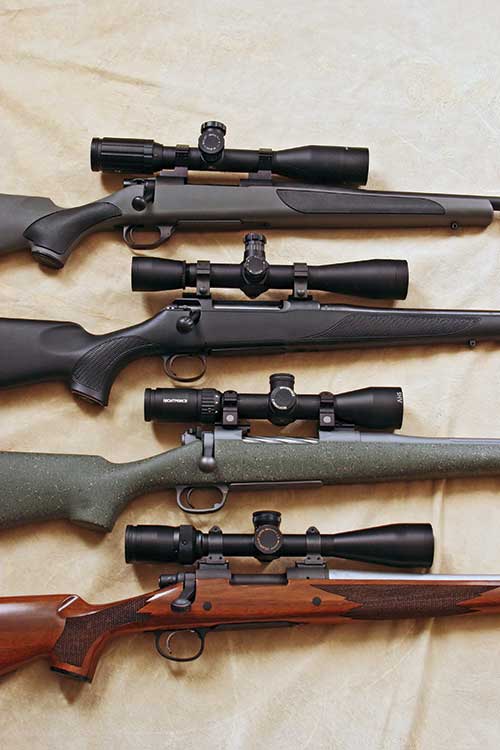
Scopes with internal adjustments rugged enough to work consistently over and over again,
tend to weigh more than typical hunting scopes. These all weigh around 20 ounces, and
include (top to bottom) a 6x42 SWFA Super Sniper on a Weatherby Vanguard 6.5 Creedmoor,
a 10x40 Leupold Mark 4 on a SAUER Model 100 .308 Winchester, a 3-10x42 Nightforce SHV
on a Legendary Arms Works .300 Winchester Magnum, and a 3-15x40 Weaver Super
Slam on a Remington 700 .204 Ruger.
What’s Best?
So many options naturally result in arguments about which scopes work best. I observed one of these “discussions” a few months ago. One of the guys was an avid elk hunter who preferred a light 6X scope with extra dots on its reticle, and the other guy a long-range instructor and competitor, who insists on higher-magnification scopes with “mil/mil” reticle and adjustments. The elk hunter ended the argument by asking the turret-twister how many 6-point bulls he’d killed.
Then there’s Jim Richards, the guy who holds the present world record for the smallest 10-shot benchrest group fired at 1,000 yards. Center-to-center it measured 2.659 inches, smaller than many deer hunters can group 10 shots at 100 yards. Jim happens to be a member of my local rod-and-gun club, partly because it has a 1,000-yard range. His scope is a 15-55x52mm Nightforce, with a tiny dot reticle that at 55X fits precisely inside the tiny bull’s-eye of the 1,000-yard benchrest target. His reticle choice would be useless to either of the other two guys.
Then there are the Burris Eliminator scopes, with internal laser rangefinders and computers. After programming the scope for your particular load, pushing a button while aiming lights up the correct LED dot for that range. Instead of dialing, or deciding which hashmark to use, just press a button and aim. The Eliminators work very well within a given range of environmental conditions.
These days there’s literally a long-range scope for just about anybody.
